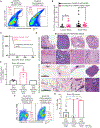Parity-induced changes to mammary epithelial cells control NKT cell expansion and mammary oncogenesis
- PMID: 34879282
- PMCID: PMC8719356
- DOI: 10.1016/j.celrep.2021.110099
Parity-induced changes to mammary epithelial cells control NKT cell expansion and mammary oncogenesis
Abstract
Pregnancy reprograms mammary epithelial cells (MECs) to control their responses to pregnancy hormone re-exposure and carcinoma progression. However, the influence of pregnancy on the mammary microenvironment is less clear. Here, we used single-cell RNA sequencing to profile the composition of epithelial and non-epithelial cells in mammary tissue from nulliparous and parous female mice. Our analysis indicates an expansion of γδ natural killer T-like immune cells (NKTs) following pregnancy and upregulation of immune signaling molecules in post-pregnancy MECs. We show that expansion of NKTs following pregnancy is due to elevated expression of the antigen-presenting molecule CD1d on MECs. Loss of CD1d expression on post-pregnancy MECs, or overall lack of activated NKTs, results in mammary oncogenesis. Collectively, our findings illustrate how pregnancy-induced changes modulate the communication between MECs and the immune microenvironment and establish a causal link between pregnancy, the immune microenvironment, and mammary oncogenesis.
Keywords: Brca1 KO; CD1d; NKT cells; mammary development; pregnancy.
Copyright © 2021 The Author(s). Published by Elsevier Inc. All rights reserved.
Conflict of interest statement
Declaration of interests The authors declare no competing interests.
Figures





Comment in
-
Parity modulates epithelial-immune cell communication.Nat Rev Cancer. 2022 Mar;22(3):130. doi: 10.1038/s41568-022-00449-2. Nat Rev Cancer. 2022. PMID: 35110730 No abstract available.
References
-
- Andrews S (2015). FASTQC A Quality Control tool for High Throughput Sequence Data (Babraham Institute).
-
- Angerer P, Haghverdi L, Büttner M, Theis FJ, Marr C, and Buettner F (2016). destiny: diffusion maps for large-scale single-cell data in R. Bioinformatics 32, 1241–1243. - PubMed
Publication types
MeSH terms
Substances
Grants and funding
LinkOut - more resources
Full Text Sources
Molecular Biology Databases
Research Materials
Miscellaneous

